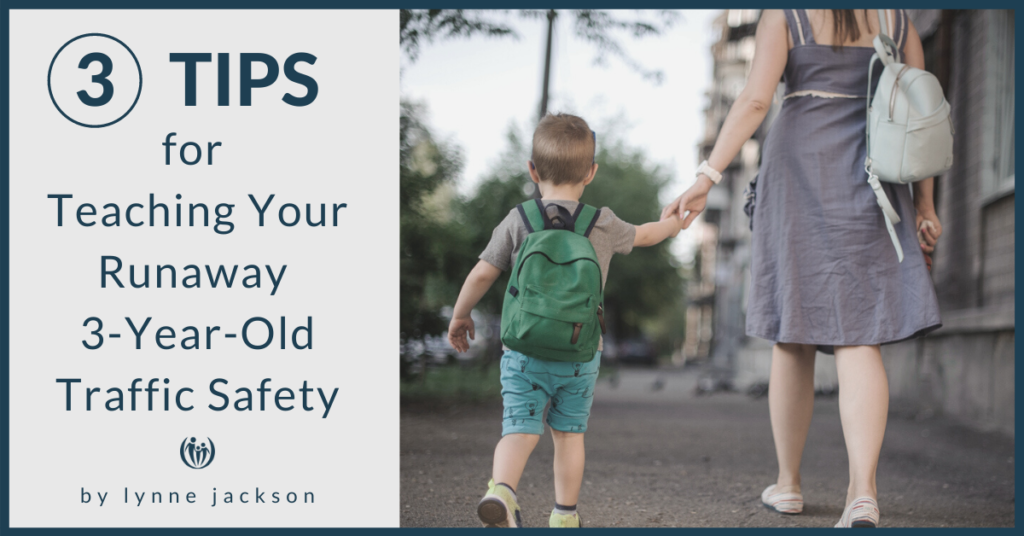
3 Tips for Teaching Your Runaway 3-Year-Old Traffic Safety

Your 3-year-old just ripped their hand out of yours and is running away from you in public. Again. This is a life-or-death situation that puts you into fight or flight mode. You scream, “STOP!” in an effort to protect them and when you finally catch them you are furious. And terrified. While buckling them into their car seat you give an angry lecture all about how dangerous that was, and how scared you were about them getting hurt. Pretty soon your child is crying and dysregulated too.
It’s normal to freak out when our kids make dangerous choices that threaten their safety!
But then what? Here’s the thing: Kids need help to understand safety concerns, and they can’t learn it in an angry lecture while you are both dysregulated. Once you are both calm there are proactive ways you can build wisdom and connection while at the same time keeping them safe from harm. We’d like to share one parent’s story that will leave you feeling equipped and encouraged to teach your child to feel safe.
One mom’s story about her 3-year-old running away
“What does Connected Families teach about obedience?” asked Hannah, during one of our workshops. She was exasperated with her defiant preschooler’s flighty behavior in a parking lot, and explained the context for her question in the following story.
When I was leaving Bible study at church, I asked my 3-year-old to stay with me, hold my hand, or I could carry him. He said he wanted to walk next to me, but then ran off several times, despite my request to “Stop now, and come to me please.” Each time I would pick him up, remind him to stay with me if he wasn’t going to hold my hand. He bucked his body and threw his hands in my face. When I got him to the car my anxiety escalated into an angry lecture – which he ignored, while his big brother giggled at the whole fiasco. Help! What could I have done differently?
Connected Families believes that learning obedience is a long process rooted in love, trust, and a parent’s wise guidance. This follows the biblical model of how we learn obedience to God — not out of fear but out of understanding how much God loves us, combined with experiencing the natural result when we disobey His wise commands (Galatians 6:7). The more we learn, the more we trust that God has really good reasons for what He tells us to do.
What messages do you want to send your child?
So let’s put that theology to the test with a feisty 3-year-old who is running away in a public place where safety is a concern.
One starting place is to realize that childhood is a long God-given phase of learning wise independence from parents. That learning process can be really messy at times. Your child is experimenting with how much he can control mom or dad and how much he can’t. Unfortunately, when parents unload their anxiety about a child’s safety into an angry or anxious lecture, the child learns that he has lots of control over his parent’s emotions.
Instead of lecturing, parents can instead focus on creative, careful communication of the messages:
- “You are safe with me”: I’m going to channel my anxiety about your disobedience away from loud lectures and into helpful teaching and boundary setting.
- “You are loved no matter what”: You are worth the thoughtful effort to teach proactively; you are loved even when you disobey.
- “You are capable and responsible to learn wise, safe behavior.”
Let’s take a look at these messages in action
Your child’s goal: run away in a parking lot.
Your goals:
- Proactively build wisdom
- Help your child practice a wise response
- Set boundaries ahead of time in ways that your child knows they are safe, loved, capable and responsible.
Here’s the thing: Kids need help to understand safety concerns, and they can’t learn it in an angry lecture while you are both dysregulated.
1) Grow wisdom through proactive teaching
God’s desire for a disobedient person (of any age) is not mindless compliance. It is growth in the “wisdom of the righteous” (Luke 1:17). Young children do not come pre-programmed with wisdom about parking lots! A parking lot can represent a lot of things to a child: a large place to run, a playground with no swings, a giant toy box with a ton of big cool cars, a way to get mom or dad to play chase with me, etc. Typically, “a dangerous place where serious injury might occur” does NOT appear on that list.
- As you approach a street or parking lot, calmly describe how easily a bug could be accidentally squished by someone’s foot if it goes on a sidewalk.
- Ask your kids, “What do you think would happen if a child were accidentally squished by a car that is so much bigger than him?” (Questions engage thinking much more than lectures!)
- Adjust your conversation based on your child’s age and anxiety level, and repeat as needed. An anxious child probably just needs calm, big picture teaching. A child with a reckless attitude might warrant more discussion about what happens to kids’ bones, blood, and skin when hit by a car.
- Reinforce how much you love your kids and want to keep them safe.
2) Practice and affirm a wise response
Now that your child has hopefully gained wisdom and motivation to help them understand the need for quick obedience, you can practice being safe!
- The game red-light (stop) green-light (run) can be a great way to reinforce listening and obeying. It also provides kids with a fun way to run that is sanctioned and safe.
- Once you’ve played that a few times, you can test it out and have your child walk toward the street or parking lot and practice calling him: “Stop! Come back to me” or even “Red light! Come here!”
- Each time he comes to you, celebrate with a hug or high five.
- Talk about how you two are a team to keep him safe. And, in this case, obedience is his main job on the team.
3) Set a clear boundary in advance
In a calm voice, before you ever get near a parking lot, establish the consequence for running away near traffic. Let him know ahead of time that if he is having trouble with his job (obedience) and starts to run away you will pick him up and carry him. No second chances. (Carry him calmly in a way that he is facing away from your face, so he can’t hurt you or watch for your reaction.)
If running away continues to be an issue, you can tell your child that you will carry him across parking lots for the next few outings. When he cooperates with being carried several times, he can have another try at walking safely next to you.
Some children could benefit from helping you choose a special backpack and strap that will keep them safe. You can put some of your child’s favorite small toys in it to interest him when away from home. When leaving to go to the car, remind him how much you love him and want to keep him safe. Ask, “Do you need the strap today or can you walk safely next to me without it?” With a question like that, most kids will predict (and therefore commit to) their success. We had one of these straps with our kids, but rarely had to use it because they learned quickly what was necessary to avoid it. This is an example of an appropriate, related consequence: the loss of freedom necessary to keep a child safe.
What if my child is making other poor choices?
Maybe your issue isn’t a 3-year-old running away from you. Instead, your child is struggling with other unsafe or poor choices that have you quite concerned. If you thoughtfully consider these steps and have a clear plan, you are less inclined to have anxious or angry reactions in the moment — and much more likely to teach your child wise behavior for the future.
So consider your challenge with your child: How can you proactively build wisdom, help your child practice a wise response, and set boundaries ahead of time in ways that your child knows they are safe, loved, capable and responsible?
Frustrated by constant discipline challenges? Take 15 minutes to read our free ebook 4 Messages All Children Long to Hear: A Discipline That Connects Overview






